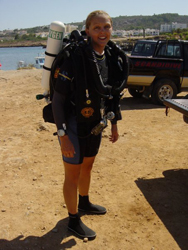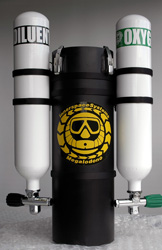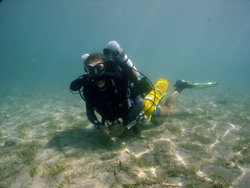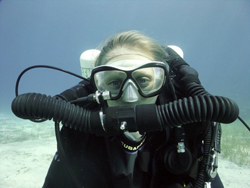Rebreather Try-Dives
Discover Rebreather Diving in Cyprus
"Wow, you look like an astronaut!"
 |
That was the first comment I heard once I was kitted up in
the Megalodon Rebreather unit at Green Bay dive site. It had
already been a day of excitement but now, this was the part I
had really been waiting for... the future of scuba...
Diving a Rebreather!!
Rebreathers are different from normal open circuit units as
they recirculate the air you breathe through a scrubber
canister to remove the carbon dioxide from the exhaled gas.
Then as the sensors detect a drop in the Oxygen levels, the
solenoid injects more to maintain a constant partial pressure
of Oxygen in the breathing mix.
The Megalodon try-dives are a full day's event with instructor, Peter Crane. The first
part of the day is spent in the classroom getting a brief over-view of the Megalodon
unit, how it works, the things that you will need to be aware of while you dive and how
to bail out to an open circuit system in case of emergency. |
In the afternoon comes the actual dive itself. A 10 minute drive from the shop to Green
Bay and you are ready to breathe the future.
At the site, Peter does a positive and
negative test on the Megalodon's counterlungs (all the other pre dive tests have been
done previously as he set the rebreather up. These are not things you need to know for
the try- dive but will learn if you progress to the modular one megalodon rebreather
diving course). Then, once suited and booted, you can put the rebreather on for the
first time and after a bit of adjusting of the harness and clipping in, I was ready to go.
Before starting the dive, the Megalodon has to be pre breathed for three minutes. This
is to start the reaction in the scrubber. Monitor the handsets, ensure the set point
remains at about 0.7 and breathe. For those of you who like the Technical Information,
let me explain what happens in the Scrubber. For those who don’t, you can skip through the technical stuff.
 |
The black canister at the back of the Rebreather is what we call the Scrubber Unit and
it is this part of the Rebreather that allows the Carbon Dioxide to be removed from the
gas we exhale so that we can breathe it again. This happens by way of a chemical
reaction
The Rebreather Diver fills the Scrubber Unit with Sofnolime. This is a granular product,
which often changes colour as it reacts, indicating that the reaction has taken place
(however, the colour change is not permanent and so you cannot use this as an
indicator for changing the scrubber.)
The Rebreather Loop is a moist area and the moisture in the loop reacts with the
Carbon Dioxide in the Diver’s exhaled breath to form a very weak Carbonic Acid. It is
this Carbonic Acid that reacts with the Sofnolime in the Scrubber Unit (a base) to
produce salt, in this instance chalk (Calcium Carbonate CaCO3), water and heat. |
This
explains why the scrubber must be changed after a set period of time (in the example
of the Megalodon rebreather Unit, the scrubber must be changed every 3 hours) and
why the breathing gas in a rebreather is always moist and warm, helping to prevent
dehydration and keeping the diver warmer underwater.
The Megalodon Dive
Standing up in waist deep water, we put on our
fins and clipped on the open circuit bail out
cylinder. After a couple of practices of bailing out,
I opened the mouth piece for the final time above
the water and we dropped below the surface.
 |
Buoyancy? What's that? All the rules for
controlling buoyancy make a runaway ascent for
the surface when you dive a rebreather! You
want to descend, so you breathe out to empty
your lungs... but you start to ascend instead.
When you want to ascend slightly to go over
some rocks, you take a deeper breath... nothing.
This is because your lungs are working together with the Megalodon's counterlungs.
You are the pump that makes the Rebreather work so you must breathe deeply and
constantly with a steady rhythm. |
Let’s take the example of emptying your lungs to descend slightly as you would with
open circuit scuba. As you continuously exhale, you are putting more Carbon Dioxide
into the loop and the Sensors will detect a drop in the Oxygen levels in the loop. This
will cause the Solenoid to fire to increase the Oxygen Levels and is therefore adding
more gas to the loop. Since the rebreather is adding gas and your exhaled gas isn’t
released you find yourself becoming more buoyant instead of less. So that golden rule
of continuous breathing when you scuba dive becomes ever more apparent when you
are diving the rebreather.
Many other factors such as depth, lung volume and even Partial pressure of oxygen
contribute to your lack of control over buoyancy but let's just say that diving a
rebreather for the first time can make the most experienced open circuit diver feel like a
complete beginner.
I was trying to Dive the Rebreather but I think really,
the Rebreather was diving me!
Once you get used to the unit and your lack of control, you begin to really enjoy the
dive. Swimming along, fish were coming right up to my face, probably intrigued by this
bizarre creature that looks like a diver but has no bubbles like the rest of them. Even
the big school of barracuda that has taken up residence in Green Bay were within
grabbing distance at certain points in the dive.
Silence! Diving has always been peaceful and a
means of getting away from the noise and hustle
on land. Rebreather diving takes it to a whole new
level. Gone is the loud sound of your own breathing
to be replaced by the occasional reassuring sound
of the solenoid firing oxygen into the loop. |
 |
Diving the rebreather has opened my eyes to a
whole new level of diving. New challenges and
experiences are a vital part of keeping interest in
any sport and the Megalodon try dive with Peter
Crane of Scuba-Tech Divers has certainly done that for me.
Would I recommend it to others? I'll probably be lining up for another go myself!!
by Shelley Patient @ Scuba-Tech Diving Centre 2010
|

